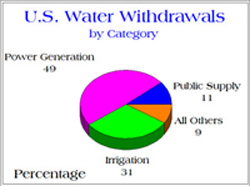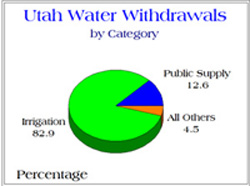U.S. Water Usage Declines Says USGS
Despite a growing population, new technologies, efficiencies and conservation efforts have saved water, but with projected population growth there will be continued pressure on U.S. water resources.
LeRoy W. Hooton, Jr.
November 22, 2009

According to a recent USGS report (Report), water usage in the U.S. has decreased over the past 35 years, despite increases in population, agriculture irrigation and electrical power generation. Since 1950, the USGS has tracked the nation's water usage and population trends in 5-year intervals. Data for the Report was collected from the 50 U.S. states, the District of Columbia, Virgin Islands and Puerto Rico for the year 2005.
In its Report, the USGS estimated that 410 billion gallons per day (Bgal/d) or 460 million acre-feet were withdrawn in 2005 for all use categories supplied from both fresh (349 Bgal/day) and saline (61 Bgal/day) water sources. This is about 5 percent less than used in the peak year of 1980 – and about the same as the 2000 USGS report.
Nationally, the largest category of water use is for thermoelectric-power generation amounting to 49 percent of the nation's fresh and saline water withdrawals of 201 Bgal/day. Thermoelectric-power generation requires large quantities of water to produce steam for the operation of turbines and water to cool the generation equipment. Besides the large number of generating plants, many of the older ones use once-through cooling methods, which can use as much as 50 gallons of water per kilowatt-hour of electricity generated. Newer plants use less water by re-circulating water or using dry cooling technologies. Withdrawals dramatically rose from 1950 to 1980 and thereafter decreased about 15 percent, and since 1985 have remained stable.
The category of irrigation water ranked second with withdrawals of 128 Bgal/day using 31 percent of the nation's fresh water resources, a value slightly less than the 2000 report. Since 1950 irrigated acreage has more than doubled from 25 million acres to 60 million acres in 2005. Most of the irrigation takes place in the West where there is inadequate natural precipitation for growing crops. Except for Arkansas, the top 10 irrigation states are located west of the 100th Meridian.
According to the Report, “Withdrawals for thermoelectric-power generation and irrigation, the two largest uses of water, have stabilized or decreased since 1980.” New technologies and efficiencies are credited for these savings.
The public supply category of users consumed 44.2 Bgal/day or 11 percent of the total fresh water withdrawals. Due to population growth of 35 percent, public supply withdrawals have increased since the USGS began its estimates in 1950. According to the Report, “The percentage of the U.S. population obtaining drinking water from public suppliers has increased steadily from 62 percent in 1950 to 86 percent in 2005.” Although the public supply withdrawal volumes have increased, the per capita consumption has decreased due to advancements in water works technology and conservation efforts.
The largest fresh water consuming states are California, Idaho, Colorado, Texas and Illinois. California, Idaho and Colorado are the largest irrigation states; and the withdrawals made by Texas and Illinois are attributed primarily to thermoelectric-generation
|
The all other category represents the remaining 9 percent of U.S. withdrawals, which accounts for water withdrawn for self-supplied industrial, livestock, aquaculture, mining and rural domestic uses.
Utah's water use profile reflects its geography, climate and demographics. It is the 12th largest in land area with 82,144 square miles and the second driest state in the U.S. with a statewide annual precipitation of 16-inches. Its total withdrawals amount to 5,120 Bgal/day or 5,730,000 acre-feet. Whereas nationally thermoelectric-generation is the single largest use of water, in Utah irrigation is the largest with 82.9 percent of its water resources used for this purpose. Public water supply follows with 607 Bgal/day, which amounts to 12.6 percent of the total withdrawals, with all other categories of use amounting to 4.5 percent.
|
Utah ranks 34th in population and 31st in total water withdrawals. Although 82.9 percent of the state's water is used for irrigation, it's only ranked 10th nationally for irrigation withdrawals of 4,000 Bgal/day. This amount is only 1/6th the amount consumed by California, the top user with 24,400 Bgal/day. California's land area is ranked 3rd in size with 156,000 square miles. Utah's northern neighbor, Idaho, is the second largest irrigation user with 16,600 Bgal/day and Colorado is third with 12,300 Bgal/day. Utah and Idaho are ranked 12th and 11th respectively in land area with over 82,000 square miles, and Colorado is ranked 8th with nearly 104,000 square miles.
Using the 2005 data contained in the Report, Utah's public water consumption was 238 gallons/day/person. Nevada, the nation's driest state, has the highest per capita consumption of 280; Idaho is 172, Colorado 185 and Arizona 237 gpd/p.
When evaluating the Report, it is clear that water planners need to be mindful of all of the man-made demands on U.S. water resources. Given the interdependency of population with the listed Report categories of water demand, as the population grows there is an accumulative impact on water resources. Each new addition to the population will require a share of water that provides for his or her public use, plus food production and electrical generation, which are all necessary to grow the economy and sustain lifestyle standards. Census forecasts predict the U.S. population will grow by another 100 million people to 400 million by 2039. Meeting growth-driven water demand will require continued efforts to conserve and implement new technologies and efficiencies for all categories of water demand. With a growing population, water resources will continue to be in the forefront of critical issues – especially in light of finite water supplies affected by natural occurring droughts and the effects of climate change.

